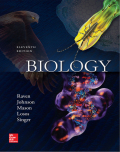
Concept explainers
What property distinguished Mendel’s investigation from previous studies?
a. Mendel used true-breeding pea plants.
b. Mendel quantified his results.
c. Mendel examined many different traits.
d. Mendel examined the segregation of traits.
Introduction:
Mendel initiated his experiment on plant hybridization using specific differences between the pea plants. The differences are comparable. For example, he recognized the inheritance of round seeds versus the inheritance of wrinkled seed. Mendel conducted his experiments in three stages; self-cross in a chosen pea plant variety, crossing of true-breeding varieties displaying alternative forms of traits, hybrid offspring production by letting them self-fertilize for several generations. Mendel counted the numbers of offspring displaying each trait in each subsequent generation. He quantified the results obtained from crosses through mathematical analysis, which led to the inheritance model that is studied until now.
Answer to Problem 1U
Correct answer:
Mendel is concerned with well define traits at a particular time, quantifying the offspring and analyzing the result mathematically. Therefore, option b. is correct.
Explanation of Solution
Reason for the correct statement:
There were five features of Mendel’s breeding experiments that were critical to his success, such as controlled crosses, use of pre-breeding strains, selection of dichotomous traits, quantification of results, and use of reciprocal and test cross.
Option b. is given as “Mendel quantified his result”.
As “Mendel was not the first to study patterns of inheritance but he was the first to use true-breeding strains as parent and to quantify the results that involve well defined variation in characteristics of pea plant in every successive generation”, it is the right answer.
Hence, option b is correct.
Reasons for the incorrect statements:
Option a. is given as “Mendel used true-breeding pea plant”.
T. A. Knight in 1823 performed cross between two varieties of the garden pea; one variety with green seeds, and the other with yellow seeds. Both varieties were true-breeding, and the offspring produced from self-fertilization remained uniform in every generation. Therefore, it is the wrong answer.
Option c. is given as “Mendel examined many different traits”.
Many other investigators made observations similar to Mendel using different traits with alternative forms of observed traits that are being distributed among the offspring. Therefore, it is the wrong answer.
Option d. is given as “Mendel examined the segregation of traits”.
One of the modern geneticists experimented the alternative forms of traits that were segregating among the progeny of a mating, observes that some offspring exhibited one form of a trait (yellow seeds), and other offspring from the same mating exhibited a different form (green seeds). Therefore, it is the wrong answer.
Hence options b., c., and d. are incorrect.
Conclusion:
The quantification of the results obtained from hybridization experiments in pea plant was the property that distinguished Mendel’s investigation from previous studies.
Want to see more full solutions like this?
Chapter 12 Solutions
EBK BIOLOGY
- State the conclusions reached by Mendel in his work on the inheritance of characteristics. Explain how each of the following deviates from these conclusions: a. Autosomal linkage b. Sex-linked (X-linked) inheritance c. Polygenic (multiple-gene) inheritancearrow_forwardWhat is Mendelian inheritance? a. Mendelian genes code an entire phenotype so that children will not be clones of their parents. b. Mendelian genetics are those genes that code for dominant or recessive illnesses but only if no polygenic traits cancel them out. c. Mendelian genes sit at one loci with one allele from Mom and one allele from Dad. d. Mendelian genetics is when two or more genes at two or more loci express one traitarrow_forwardWhat does a bell-shaped curve of a graph indicate? A. Mendelian inheritance pattern B. Incomplete dominance C. Codominance D. Continuous variationarrow_forward
- List Mendel’s conclusions from his experiments. How do the conclusions relate to what is known today in the field of genetics?arrow_forward[ Choose ] The F1 population produced flowers in a 3:1 ration of dominant to recessive traits. The F2 population produced flowers in a 3:1 ration of dominant to recessive traits. Mendel cross-bred F1 plants with F2 plants. Mendel labeled the offspring of the first plants bred F1, for the first filial generation Mendel crossed two identical, true-breeding plants for a particular characteristic. Mendel cross-bred F1 plants with each other. Mendel crossed two contrasting true-breeding plants with two different traits for a given characteristic. Mendel labeled the offspring of the first plants bred F1, for the first flower generation.arrow_forwardWhy was Mendel’s success dependent on his studying characteristics that exhibit only two easily distinguished phenotypes, such as white versus gray seed coats and round versus wrinkled seeds? Would he have been less successful if he had instead studied traits like seed weight or length of the leaves, which vary much more in their phenotypes? Explain your answer.arrow_forward
- 50 Mendel formulated his Law of Segregation after he had: Select an answer and submit. For keyboard navigation, use the up/down arrow keys to select an answer. a studied F1 offspring b studied F2 offspring C produced mutations identified chromosomesarrow_forwardExplain why it is important that Mendel had a large sample size of offspring to count in his experiments.arrow_forwardWhy was Mendel’s success dependent on his studying characteristics that exhibit only two easily distinguished phenotypes, such as white versus gray seed coats and round versus wrinkled seeds? Would he have been less successful if he had instead studied traits such as seed weight or leaf length, which vary much more in their phenotype?arrow_forward
- Determine the reason as to why Mendel's approach to study heredity was successful.arrow_forwardexplain how Mendel developed his theories of genetics.arrow_forwardWrite out Mendel’s first and second laws (also known as his four postulates) and provide one piece of evidence from his work that supports each law.arrow_forward
 Human Heredity: Principles and Issues (MindTap Co...BiologyISBN:9781305251052Author:Michael CummingsPublisher:Cengage Learning
Human Heredity: Principles and Issues (MindTap Co...BiologyISBN:9781305251052Author:Michael CummingsPublisher:Cengage Learning
